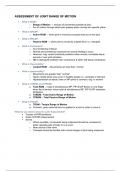Summary
Summary Range of Motion Assessment
- Course
- Institution
Highly detailed summary of the content for all the ROM Assessment lectures. Includes work from lecture slides, textbook/reading annotations and external research where further explanation was needed.
[Show more]



